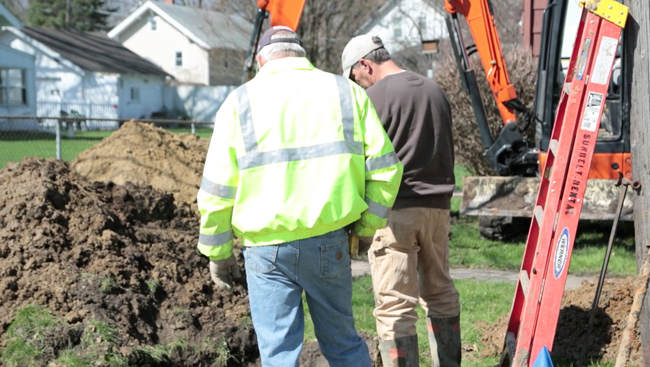Aging Infrastructure Creates Challenges For Utilities And Their Customers

By Myles Meehan, Senior Vice President, Public Relations, HomeServe USA
It’s no great secret that a sound infrastructure plays a critical role in the health of our economy and our individual health. A first-class infrastructure — not just well-maintained, but modernized and innovative — is the hallmark of a first-class nation. In the United States, up until relatively recently, building the best roads, bridges, railroads and water supply systems was a priority for that very reason. The literal foundation of America was once among the strongest in the world.
But the World Economic Forum Global Competitiveness Report from 2012-2013 ranks the overall quality of the United States’ infrastructure 25th, below most of our major trading partners, and even a number of developing nations. Somewhere along the way, infrastructure not only ceased being a priority across America, it fell completely off the agenda.
Our water and wastewater systems have not been spared by our years of neglect. In its 2013 Report Card for America’s Infrastructure, the American Society for Civil Engineers (ASCE) scored the condition of the U.S.’s drinking water and wastewater infrastructure grades of “D” — a mere letter grade above total failure.
Though the problems facing what some consider our floundering water and wastewater systems are extensive and complex, the source of these problems can be boiled down to this: we’ve underinvested. Now, there’s a price to pay, and everyone, from municipal government to utilities to individual homeowners, has to foot the bill.
Our Crumbling Water and Wastewater Infrastructure
The unfortunate reality is that water and sewer mains in the U.S. are either approaching or have already exceeded their useful life. According to Water is Your Business, a campaign by the National Association of Water Companies and the U.S. Chamber of Commerce, the useful life of a water pipe ranges from just 15 years to 95 years, with the average age of a broken water main coming in at 47 years. Similarly, the Congressional Budget Office estimates the average useful life of a sewer line to be 50 years. Close to one-fourth of water mains in the U.S. were installed over fifty years ago. In other words, one-fourth of water mains are at least 3 years past the average age of failure. An even higher percentage — 45 percent — is considered to be in poor condition, up from just 10 percent thirty years ago. It thus comes as no surprise that the ASCE estimates an average of 650 water main breaks occur every day in the U.S. Not only do these broken water mains and pipes cost millions in repairs, they also result in the loss of an estimated 7 billion gallons every day.
The condition of sewer mains in the U.S. is just as dire: most sewer mains were installed shortly after World War II, over sixty years ago, the ASCE 2013 Report Card informs us. Moreover, because our sewer systems have not been updated since the 1940s, nor were they designed with today’s population in mind, they don’t have the capacity to handle the amount of inflow currently being generated. The result is the unintentional release of 900 billion gallons of untreated sewage annually, according to the Environmental Protection Agency.
Hitting Too Close to Home
It isn’t just the public water and sewer mains that are deteriorating with age; the residential water and sewer pipes on homeowner property connected to this public infrastructure are also in danger of failure. According to U.S. Census data, 50 percent of American homes were built over 40 years ago, and a third is over 50 years old. The water and sewer pipes supplying these homes were likely installed at around the same time. These residential pipes are old and if they haven’t been repaired or replaced already, that day is approaching. HomeServe estimates that 1.1 million homeowners will suffer a water service line emergency in 2014 — a rate of one water line emergency every 30 seconds — and 4.3 million homeowners will experience a sewer line disruption. The rate of failure is likely to increase as American homes and pipes continue to get older.
For many American homeowners, a broken water or sewer pipe is more than a home emergency; it’s a financial emergency beyond their means. Most basic homeowner insurance policies do not cover repairs to damaged water or sewer lines, and many private or public utilities are not responsible for covering the cost for a broken line on residential property. In almost all cases, the homeowner is responsible for footing the bill. Replacing a section of a water service line costs, on average, $2,223.00, according to HomeServe, and replacing a damaged sewer service line costs an average of $3,697. Considering 64 percent of consumers do not have $1,000 to cover unexpected expenses, as noted by a 2011 survey from the National Foundation for Credit Counseling, these emergency repairs are expenses most Americans can ill-afford.

Broken Pipes = Broken Customer Relationships
Technically speaking — and with a few exceptions — it is the homeowner who bears full responsibility for paying for and managing the repairs of a damaged water or sewer service line that falls on their private property. However, 61 percent of American homeowners surveyed in a 2012 Ipsos Public Affairs Poll were not aware of that responsibility. And the first place many homeowners turn to when faced with water or sewer line emergencies is their local utility. Their expectation is that, as a provider of water and wastewater services to the community, the utility is the go-to source for help.
The utility has no obligation to offer the homeowner any assistance; it’s the homeowner’s burden to bear. But the end result, should the utility decide to take that approach, is a disgruntled customer who doesn’t understand why their service has been disrupted, and who is in a panic because they’re stuck with a thousand-dollar-plus bill. Saying “this isn’t our problem” does nothing to foster a good relationship with the customer or with the broader community.
But because the utility is looked upon as a community resource, there is a real opportunity for utilities to strengthen this relationship. Instead of saying, “this isn’t our problem,” utilities can educate homeowners on their responsibilities and provide them with a solution.
Across the nation, some utilities and municipalities have begun tackling this problem. They are taking a two-pronged approach of education and protection. Firstly, homeowners need to be aware of what their responsibility is, what basic homeowners insurance covers, and what utilities cover. Beyond education, homeowners need an affordable means of protecting themselves from the expense and inconvenience of a broken water or sewer pipe. To that end, some utilities are now offering their customers home emergency repair service plans for a small monthly fee — protection plans that cover the cost of repairs for a water or sewer service line break — either on their own or through a partner provider. Much like insurance, water and sewer line repair service plans provide customers with peace of mind that should an emergency occur, they are protected from the unexpected expense. But a repair service plan goes one step further, also sparing the customer the inconvenience of identifying and hiring a reputable contractor and managing the repair process themselves.
Not only does the introduction of these protection plans provide the opportunity for education and help solve customer service needs, they also serve as an additional source of revenue for the utility and can improve customer satisfaction by an average of 37 percent, according to a 2012 Ipsos Public Affairs poll of utility customers. The same poll also found more than half (55 percent) of utility customers believe utilities should offer these types of protection plans as options. As more utilities roll out these types of programs nationwide, demand is likely to increase alongside customer expectations for utilities to have an active role in helping to resolve residential water and wastewater issues. Utilities can continue to have a hands-off role — and explain to customers that water line and sewer line repairs on private property are outside their jurisdiction — or they can step in with a solution.
Of course, the best solution we could offer homeowners would be a significant investment in rebuilding our water and wastewater systems and a recommitment to making America’s infrastructure the best in the world. That’s something we as a country should still strive for. But in the interim, utilities continue to be exposed to and receive the blame — perhaps unfairly — from their customers for water and sewer infrastructure breakdowns. Inevitably, this blame extends to not only public water and sewer mains, but residential service lines in which utilities have traditionally not held a role. A dual-pronged approach of education and protection can go a long way to fixing problems, at least on the homeowner’s side of the fence, when they occur and build even stronger customer relationships.
Myles Meehan is senior vice president of public relations at HomeServe USA, a leading provider of home emergency repair service plans. Meehan has more than 30 years’ experience working with utilities in both the water and energy sectors. He can be reached at myles.meehan@homeserveusa.com.
